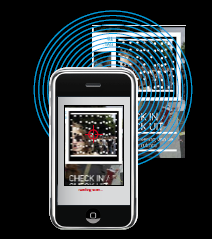Book review: Check in / check uit – Christian van ‘t Hof, Rinie van Est, Floortje Daemen
 Title: Check In / Check Uit – de digitalisering van de openbare ruimte
Title: Check In / Check Uit – de digitalisering van de openbare ruimte
English version: Check In / Check Out – the Public Space as an Internet of Things
Authors: Christian van ‘t Hof, Rinie van Est, Floortje Daemen
Publisher: Rathenau Instituut, NAi Uitgevers
Published: January 2011
ISBN: 978-90-5662-808-6
The title of the book already covers most of where this book is about: how we check in and check out on the net more and more in public space. We do it when we walk through public transport gates, when we get cash from an ATM or check in to an office. This is shown in the six case studies as listed below.
- The public transport chip card (OV chip card)
- Surveillance camera’s (CCTV)
- Near Field Communication (technology in mobile phones for exchanging information, identification and payments)
- The Networked Car (road pricing and GPS systems)
- Google Earth (Google Street View, Google Latitude)
- The Living Map (locative media)
All phenomena in the cases are explained and cover the history, future, commotion around the topic, safety, implementations, technique; the approaches on the cases are truly diverse and divided into short chapters, so it is very easy to pick the parts out that interest you. Especially to study the term identity management, the authors make use of the classic W-questions: Who is the provider? What actions take place in the system? Which technologies are used? Where does one check in to the system and how does this registration contribute to the management of his or her identity? When did the action take place, when did the planning and implementation start and when where the most important turning-points? And Why, what are the underlying ideas of the system?
From the seventies the social debate on information technology is fed by both the empowerment and the privacy discourse. In the empowerment discourse the central question is how information technology helps people to enrich en arrange their lives. Both concepts function as central guidelines throughout the book and for every case study the authors show both advantages (empowerment) and (mostly disadvantages and problems in the case of) privacy issues. The last chapter is about identity management, a combination of the two terms mentioned above. In this chapter the authors give a summary on which technological trends made the transformation in the net possible, what the social meaning of these phases is in the information society and the role citizens can play in managing their (digital) identity.
Check in / Check uit includes many extracts of the Dutch law to illustrate the cases and examples concerning privacy, e.g. the ‘Wet bescherming persoonsgegevens’ (the law protecting personally identifiable information). Both the role of the citizens as the role of the Dutch government are attended to the matter. The six case studies work excellent for making theory concrete and practically understandable, something that is tend to be lacking in many new media theory books. Sometimes the book gets quite technical, as in the case of the piece on the technical system behind the kilometre tax. Sometimes it can get a bit blurry in your head when you read so much information and so many technical terms, but luckily there is a technical terms and abbreviations list included in the back of the book. The most interesting parts of the book are those where the area of tension between empowerment and privacy is demonstrated. Sometimes the authors even reveal their own perspectives and point of view on topics based on the conclusions of the case studies, for example on the public transport chip card:
“In our opinion, the system is too much forced on the public travellers by the transport companies” (p. 68).
They also come up with ideas to find a good balance on the two central terms in certain cases.
 TAG / SCAN / CHECK
TAG / SCAN / CHECK
The book already gives a lot of information and examples, but for those that just cannot get enough of it or want to read more on a specific they have included tags. After you have downloaded the right application, you can scan them with your smartphone and you get redirected to a website, movie or text message with extra information. Besides all the case studies the book itself is a living example on what phenomenon is discussed in the book: the digitisation of things and public space. All this included makes Check in / Check uit a real valuable database and a real recommendation for anyone interested in Dutch privacy issues concerning new media and new technologies. One last thing to say on this book: many credits go to the design: although yet an old medium, it looks super modern, flashy and appealing.
Grade: 8/10